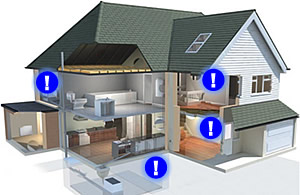
I’m taking a break today from writing about Maine lakefront real estate to pass along a “Heads Up!” from our State Department of Public Safety about carbon monoxide (CO) poisoning and protecting yourself from it.
It’s wintertime and homes are being heated by oil, gas, and wood, with CO as a byproduct. Homes are also being kept closed up, thereby keeping air exchange and ventilation to a minimum.
See all those little exclamation points in the photo above? Those are all the places that experts say you should have a carbon monoxide detector to protect you and your family.
As you probably know, carbon monoxide is an odorless, colorless gas that is given off in the combustion of fuel when heating your home (in this case) whether you have an oil furnace, gas furnace, or wood stove. The best protection is achieved by making sure your heating system is working properly and is vented properly. You should have a professional check your heating system every year. Installing carbon monoxide detectors can further insure that you won’t be victimized by this lethal gas.
Here are a few tips about installing your CO detector:
CO alarms should be installed in a central location outside each separate sleeping area and on every level of the home. For the best protection, interconnect all CO alarms throughout the home. When one sounds, they all sound.
Follow the manufacturer’s instructions for placement and mounting height.
Choose a CO alarm that has the label of a recognized testing laboratory. Not all CO alarms are created equal. Buyer beware!
Test CO alarms at least once a month; replace them according to the manufacturer’s instructions.
CO alarms are not substitutes for smoke alarms.
The International Association of Fire Chiefs recommend a carbon monoxide detector on every floor of your home, including the basement. A detector should be located within 10 feet of each bedroom door and there should be one near or over any attached garage. Each detector should be replaced every five to six years.
Okay – don’t say you haven’t been warned. If you don’t have CO detectors you should seriously consider buying some and installing them. Remember the old Yankee adage – an ounce of prevention is worth a pound of cure. Don’t shortchange your family’s safety. Check into this today.
Maine Lakefront Property – In Bridgton They’re Freezin’ for a Reason
January 27, 2009Casco Offers Up a Wide Variety of Maine Lakefront Property
February 2, 2009Maine Lakefront Homes – Protecting Yourself From Carbon Monoxide
I’m taking a break today from writing about Maine lakefront real estate to pass along a “Heads Up!” from our State Department of Public Safety about carbon monoxide (CO) poisoning and protecting yourself from it.
It’s wintertime and homes are being heated by oil, gas, and wood, with CO as a byproduct. Homes are also being kept closed up, thereby keeping air exchange and ventilation to a minimum.
See all those little exclamation points in the photo above? Those are all the places that experts say you should have a carbon monoxide detector to protect you and your family.
As you probably know, carbon monoxide is an odorless, colorless gas that is given off in the combustion of fuel when heating your home (in this case) whether you have an oil furnace, gas furnace, or wood stove. The best protection is achieved by making sure your heating system is working properly and is vented properly. You should have a professional check your heating system every year. Installing carbon monoxide detectors can further insure that you won’t be victimized by this lethal gas.
Here are a few tips about installing your CO detector:
CO alarms should be installed in a central location outside each separate sleeping area and on every level of the home. For the best protection, interconnect all CO alarms throughout the home. When one sounds, they all sound.
Follow the manufacturer’s instructions for placement and mounting height.
Choose a CO alarm that has the label of a recognized testing laboratory. Not all CO alarms are created equal. Buyer beware!
Test CO alarms at least once a month; replace them according to the manufacturer’s instructions.
CO alarms are not substitutes for smoke alarms.
The International Association of Fire Chiefs recommend a carbon monoxide detector on every floor of your home, including the basement. A detector should be located within 10 feet of each bedroom door and there should be one near or over any attached garage. Each detector should be replaced every five to six years.
Okay – don’t say you haven’t been warned. If you don’t have CO detectors you should seriously consider buying some and installing them. Remember the old Yankee adage – an ounce of prevention is worth a pound of cure. Don’t shortchange your family’s safety. Check into this today.
Stay Informed
Get the latest lake news delivered direct from Maine’s lake expert, Tom Ferent